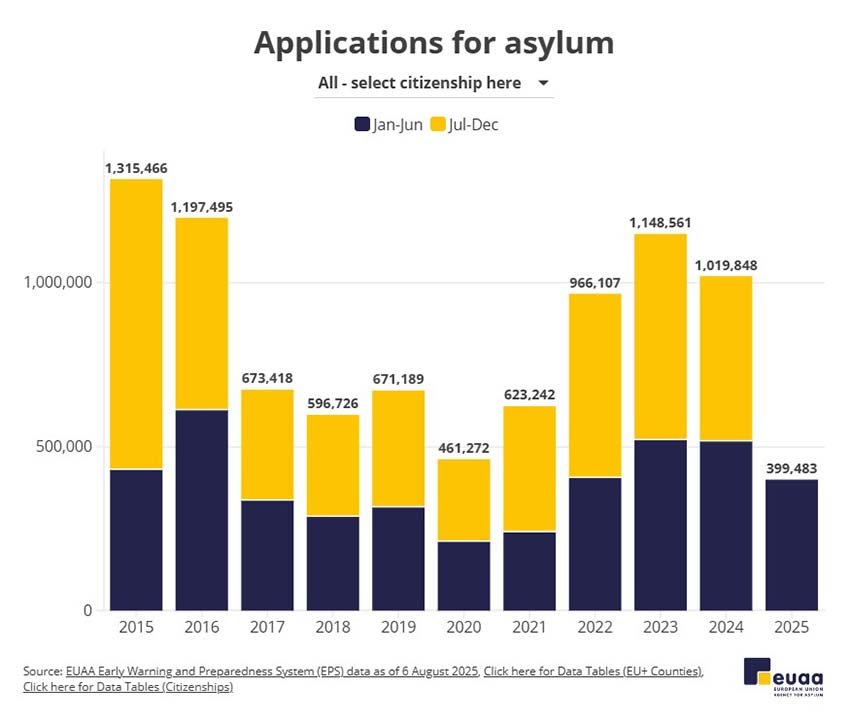читайте также
 Italy May End Tax Relief on Rental Income: What It Means for Landlords and Investors
Italy May End Tax Relief on Rental Income: What It Means for Landlords and Investors
 Luxury Travel Takes Off: How Demand Is Changing and Where to Find ‘Quiet Luxury’
Luxury Travel Takes Off: How Demand Is Changing and Where to Find ‘Quiet Luxury’
 Airbnb shifts all fees to property owners
Airbnb shifts all fees to property owners
 Most Punctual Airlines of September 2025: Who Arrived on Time and Why It Matters
Most Punctual Airlines of September 2025: Who Arrived on Time and Why It Matters
 Ten Years to a Passport: New Citizenship Rules in Portugal
Ten Years to a Passport: New Citizenship Rules in Portugal
 Top 25 World Economies 2025: Who Shapes Global Growth
Top 25 World Economies 2025: Who Shapes Global Growth
Refugees in Europe 2025: Record Low Approval Rates

Photo: EUAA
In the first half of 2025, EU countries received 399,000 asylum applications—23% fewer than in the same period of 2024. For the first time in a decade, the top nationality changed: Venezuelans overtook Syrians. France and Spain registered the most applications, surpassing Germany. Overall approval rates fell sharply.
According to the European Union Agency for Asylum (EUAA), Venezuelan nationals filed 49,000 requests in six months (+31%). Spain accounted for 93% of these cases (+29%), driven by a shared language, a large diaspora, and Spain’s special national protection pathway for Latin Americans.
Temporary protection for Ukrainian refugees: tightened rules and record-low new decisions
Afghans ranked second with roughly 42,000 applications (about 10% of the total). Despite the high level, their numbers have been easing since 2023. Syrians, long-time leaders, dropped to third with 25,000 applications—66% less than last year. The shift is linked to the collapse of the Assad regime in December 2024: many EU states paused Syrian case processing, while some applicants withdrew their claims—counted statistically as rejections.
Next came Bangladesh and Turkey with 17,000 each, both down (–26% and –41%, respectively). Ukrainians saw a 29% rise, applying mostly in France and Poland; however, these figures are incomparable with temporary protection, held by 4.3 million Ukrainians by end-June.

By destination, France recorded the most applications (78,000, flat year-on-year). Spain was second (77,000, –13% YoY). Germany placed third (70,000, –43%). Italy also fell (–25% to 64,000). Greece ranked fifth (27,000) but had the highest per-capita pressure: 1 application per 380 residents.
The recognition rate in H1 2025 hit an all-time low of just 25%, largely due to the Syrian dynamic. Some country rates were unchanged: Bangladesh 4%, Pakistan 10%, Nigeria 10%. By contrast, Mali saw approvals jump from 41% (2021) to 79% (2025), on ~9,000 applications (–6%), mostly in Spain. Haiti also surged—from 10% (2020) to 86% (2025)—with applications up 27% to 7,200, almost 99% filed in France, where Haitian arrivals rose 57%.
Overall, more than half of applications came from nationalities with low recognition (≤20%). Many of these cases can be fast-tracked under new procedures slated to enter into force in mid-2026. As of end-June, the EU had 918,000 first-instance cases pending.
Eurostat data show that in 2024 the EU registered 912,000 first-time asylum applications (–13% vs 1,049,500 in 2023). Syria led with ~148,000, followed by Venezuela (72.8k) and Afghanistan (72.1k). Colombia (50.3k), Turkey (46.8k) and Bangladesh (37.8k) also posted high numbers. Russia filed 13.5k applications in 2024 (vs 17.9k in 2023).
The biggest national caseloads in 2024 were Germany (229.7k), Spain (164k), Italy (151.1k) and France (130.9k), with Greece (69k) rounding out the top five. On a per-capita basis, Cyprus led with 7.2 per 1,000 residents.
Europe’s asylum system is entering a containment phase. New rules are being built at both EU and member-state level. Obtaining status has never been easy—and procedures are becoming even stricter. Experts advise considering asylum only as a last resort. While tighter rules may ease state burdens, they also risk heightening tensions around irregular migration.
Подсказки: Europe, EU, asylum, refugees, EUAA, Eurostat, Venezuela, Syria, Afghanistan, France, Spain, Germany, Greece, recognition rate, immigration policy, migration, backlog, approvals, humanitarian, 2025





